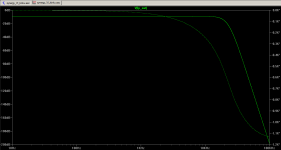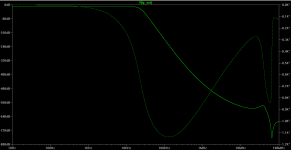I haven't come across AADE before - is this something free I can download or is it a commercial piece of software?
As regards your passive I/V stage I figured when I noticed you were considering FDNR filters you'd not be in need of the passive stage so consigned it to the back burner and have been getting on with other interesting stuff. I'll eventually get around to the schematic because I need it for getting my own PCB done but its low priority unless I see an urgent need which it seems you don't have
As regards your passive I/V stage I figured when I noticed you were considering FDNR filters you'd not be in need of the passive stage so consigned it to the back burner and have been getting on with other interesting stuff. I'll eventually get around to the schematic because I need it for getting my own PCB done but its low priority unless I see an urgent need which it seems you don't have
AADE is completely free, and it has lot more options to design passive filters than anything I have came across.
Please give it a try and you won't be disappointed.
FDNR is something I am considering. Hopefully you will still keep the stuff in back burner and won't discard completely.
Please give it a try and you won't be disappointed.
FDNR is something I am considering. Hopefully you will still keep the stuff in back burner and won't discard completely.
Seems like things have come to the point where decision to be made about allowing at least first image to appear at the input of amplifier ( Bessel) vs using a Tebeschev filter which introduce phase distortions but cut steeply at 20Khz. Not sure which is going to cause most damage?
http://www.ti.com/lit/an/sloa049b/sloa049b.pdf
Conclusion
We have investigated building second-order low-pass Butterworth, Bessel, and 3-dB Chebyshev filters using the Sallen-Key and MFB architectures. The same techniques are extended to higher-order filters by cascading second-order stages for even order, and adding a first-order stage for odd order.
The advantages of each filter type come at the expense of other characteristics. The Butterworth is considered by a lot of people to offer the best all-around filter response. It has maximum flatness in the pass-band with moderate rolloff past cutoff, and shows only slight overshoot in response to a pulse input.
The Bessel is important when signal-conditioning square-wave signals. The constant-group delay means that the square-wave signal is passed with minimum distortion (overshoot). This comes at the expense of a slower rate of attenuation above cutoff.
The 3-dB Chebyshev sacrifices pass-band flatness for a high rate of attenuation near cutoff. It also exhibits the largest overshoot and ringing in response to a pulse input of the three filter types discussed.
The Sallen-Key and MFB architectures also have trade-offs associated with them. The simplifications that can be used when designing the Sallen-Key provide for easier selection of circuit components, and at unity gain, it has no gain sensitivity to component variations. The MFB shows less overall sensitivity to component variations and has superior high-frequency performance.
Out of curiosity I wanted to see what I could come up with, cascading 3rd order filters. I'm not suggesting that this is a good idea, or sensible but I thought I'd post it anyway.
It is extremely parts heavy, requiring a buffer between each filter, I suspect the distortion would be quite high as a result (I haven't done a transient analysis), and the phase starts to change at about 100Hz, total phase rotation close to 1200 degrees But the rolloff is nice
But the rolloff is nice 
This is basically 5 3rd order FDNR's in series with a buffer between each. Whether it would be stable is anyones guess. A fun excercise but not something I think I would try in practice.
Tony.
It is extremely parts heavy, requiring a buffer between each filter, I suspect the distortion would be quite high as a result (I haven't done a transient analysis), and the phase starts to change at about 100Hz, total phase rotation close to 1200 degrees
This is basically 5 3rd order FDNR's in series with a buffer between each. Whether it would be stable is anyones guess. A fun excercise but not something I think I would try in practice.
Tony.
Attachments
For very high gain/slope filters, DSP is pretty much the best way to go these days - there are quite a few 48dB digital Xovers and also some 96dB ones (ie the well known DEBX units used by OverKill Audio, etc) and some less exotic units also
Trying to build high slope analogue filters is extremely difficult to get 'the sound' anywhere near 'right' - 24dB filters are bad enough!
Trying to build high slope analogue filters is extremely difficult to get 'the sound' anywhere near 'right' - 24dB filters are bad enough!
Schematica 555 timer and active filter design software
has an active/passive filter design software ,Filter wiz pro. there is a simple free version and pro version you can experiment with but actual value of resistors are masked until you purchase the license. So far it seems the best option I have experimented with. Even has BIQUAD filters( Tow -Thomas and Akerberg-Mossberg) available as option. Have a look guys very promising to me. Especially if you bunked all Maths lessons ...
has an active/passive filter design software ,Filter wiz pro. there is a simple free version and pro version you can experiment with but actual value of resistors are masked until you purchase the license. So far it seems the best option I have experimented with. Even has BIQUAD filters( Tow -Thomas and Akerberg-Mossberg) available as option. Have a look guys very promising to me. Especially if you bunked all Maths lessons ...
- Status
- This old topic is closed. If you want to reopen this topic, contact a moderator using the "Report Post" button.
- Home
- Source & Line
- Digital Line Level
- Using FDNR's for NOS DAC Anti Imaging filter


